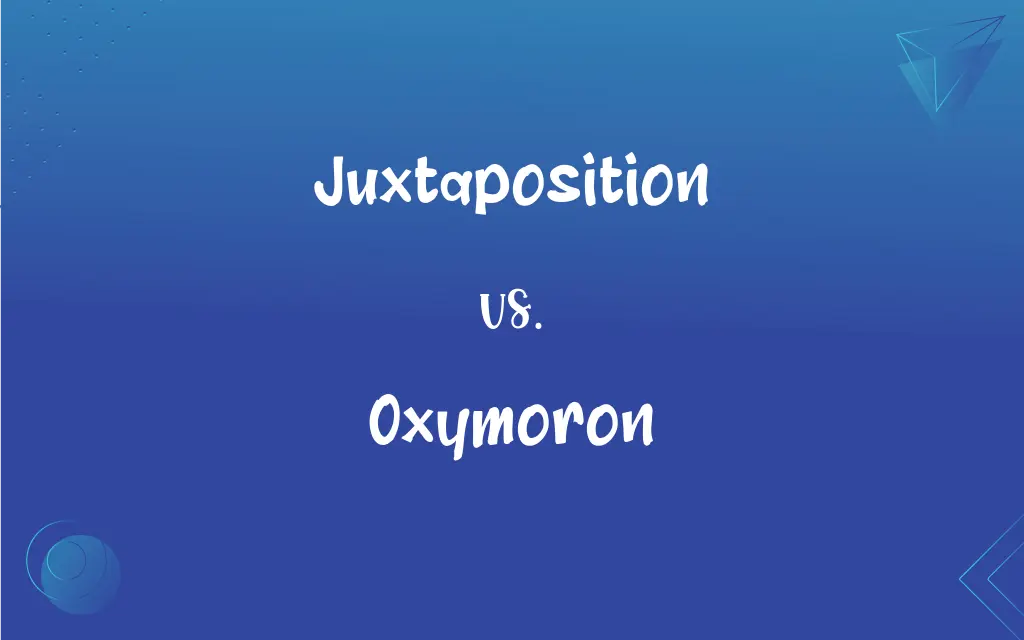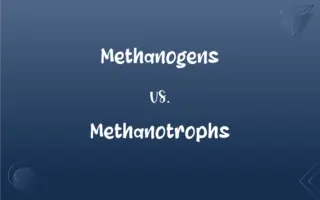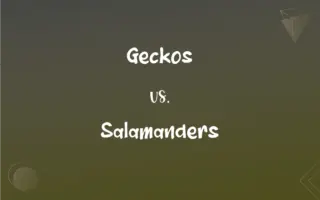Juxtaposition vs. Oxymoron: What's the Difference?
Edited by Aimie Carlson || By Janet White || Published on February 28, 2024
Juxtaposition places different elements side by side for comparison or contrast, while an oxymoron combines contradictory terms into a single expression.

Key Differences
Juxtaposition is a literary technique where two or more ideas, places, characters, or actions are placed close together for the purpose of developing comparisons and contrasts. An oxymoron, however, is a figure of speech that combines two contradictory terms into a single paradoxical expression, like 'bittersweet'.
In juxtaposition, contrasting elements, such as characters or themes, are placed next to each other to highlight their differences or similarities. Oxymorons, in contrast, create a unique effect by merging opposites in a way that seems nonsensical but often reveals a deeper truth, as in 'deafening silence'.
Juxtaposition does not necessarily involve contradiction but relies on the proximity of contrasting elements to enrich meaning. Oxymorons inherently embody contradiction, fusing conflicting ideas into one phrase, such as 'living death'.
Juxtaposition can be subtle, relying on the audience's perception to notice and interpret the contrast or similarity. Oxymorons are more overt in their contradiction, immediately presenting a paradox that challenges conventional thinking.
Juxtaposition is a broader narrative technique used across various art forms, while oxymoron is specifically a rhetorical device used in language to convey complex ideas through contradiction.
ADVERTISEMENT
Comparison Chart
Definition
Placement of different elements side by side
Combination of contradictory terms
Purpose
To compare or contrast
To create a paradoxical expression
Usage
In various art forms for thematic depth
In language as a rhetorical device
Dependency on Contradiction
Not necessary
Inherent
Effect on Audience
Subtle perception of contrast
Immediate recognition of paradox
ADVERTISEMENT
Juxtaposition and Oxymoron Definitions
Juxtaposition
Placing contrasting elements together to emphasize differences or similarities.
The juxtaposition of the bustling city next to the calm countryside highlighted the extremes of urban and rural life.
Oxymoron
A figure of speech combining contradictory terms.
The phrase open secret is an oxymoron that implies widespread yet unacknowledged knowledge.
Juxtaposition
A literary technique for developing contrast or comparison.
In the novel, the juxtaposition of the protagonist's poverty against the antagonist's wealth underscored the theme of inequality.
Oxymoron
Contradictory terms used together for rhetorical effect.
Cruel kindness is an oxymoron that reflects a complex emotional state.
Juxtaposition
Side-by-side placement for thematic or narrative effect.
The artist's juxtaposition of warm and cool colors created a striking visual tension.
Oxymoron
A paradoxical expression highlighting the complexity of ideas.
The concept of jumbo shrimp is an oxymoron that plays on contradictory sizes.
Juxtaposition
A tool for highlighting differences or similarities between elements.
Juxtaposition of old and new architectural styles in the city center illustrates the passage of time.
Oxymoron
Used in language to convey contradictory, yet related, concepts.
Describing a situation as bitterly sweet employs an oxymoron to express mixed feelings.
Juxtaposition
Used in various art forms to enhance meaning through contrast.
The movie's juxtaposition of comedy and tragedy deepened the emotional impact of the story.
Oxymoron
A linguistic tool for expressing complex, contradictory ideas.
Deafening silence is an oxymoron that captures the overwhelming presence of complete quiet.
Juxtaposition
The act or an instance of juxtaposing or the state of being juxtaposed.
Oxymoron
A rhetorical figure in which incongruous or contradictory terms are combined, as in a deafening silence and a mournful optimist.
Oxymoron
(rhetoric) A figure of speech in which two words or phrases with opposing meanings are used together intentionally for effect.
Oxymoron
A contradiction in terms.
Oxymoron
A figure in which an epithet of a contrary signification is added to a word; e. g., cruel kindness; laborious idleness.
Oxymoron
Conjoining contradictory terms (as in `deafening silence')
FAQs
Can juxtaposition be visual?
Yes, it's used in visual arts to contrast colors, shapes, or themes.
What is juxtaposition in literature?
It's placing contrasting elements close together to highlight differences or similarities.
Does juxtaposition imply opposition?
Not always, it can also highlight similarities.
What's an example of juxtaposition in film?
Placing a chaotic scene next to a peaceful one to highlight contrast.
How does an oxymoron function?
An oxymoron combines contradictory terms to create a paradoxical expression.
Is juxtaposition a narrative technique?
Yes, it's used in storytelling to develop characters, themes, or settings.
Are oxymorons always two words?
Typically, but they can be longer phrases with contradictory elements.
Are oxymorons confusing?
They can be initially puzzling but are used to convey complex ideas.
Do oxymorons always make sense?
They make sense in a paradoxical way, often revealing deeper meanings.
Can oxymorons be unintentional?
They're usually deliberate for rhetorical effect, but accidental oxymorons can occur.
Can oxymorons be humorous?
Yes, they're often used for comedic effect due to their paradoxical nature.
What's a simple example of an oxymoron?
"Pretty ugly" is a straightforward oxymoron.
Does juxtaposition help in character development?
Yes, by contrasting characters, authors can highlight specific traits.
Is an oxymoron a type of irony?
It can be, as it often involves a contrast between expectations and reality.
How does juxtaposition affect mood?
It can intensify emotions by contrasting or comparing different elements.
Are oxymorons common in poetry?
Yes, poets use them to add depth and complexity to their language.
Is "silent scream" an oxymoron?
Yes, it combines contradictory concepts of silence and loudness.
Can juxtaposition create irony?
Yes, by placing contrasting elements together, it can produce ironic effects.
Does juxtaposition require physical closeness?
In literature and art, it's more conceptual closeness than physical.
Is juxtaposition only used in art and literature?
It's most common in creative fields but can be found in everyday scenarios.
About Author
Written by
Janet WhiteJanet White has been an esteemed writer and blogger for Difference Wiki. Holding a Master's degree in Science and Medical Journalism from the prestigious Boston University, she has consistently demonstrated her expertise and passion for her field. When she's not immersed in her work, Janet relishes her time exercising, delving into a good book, and cherishing moments with friends and family.
Edited by
Aimie CarlsonAimie Carlson, holding a master's degree in English literature, is a fervent English language enthusiast. She lends her writing talents to Difference Wiki, a prominent website that specializes in comparisons, offering readers insightful analyses that both captivate and inform.






































































